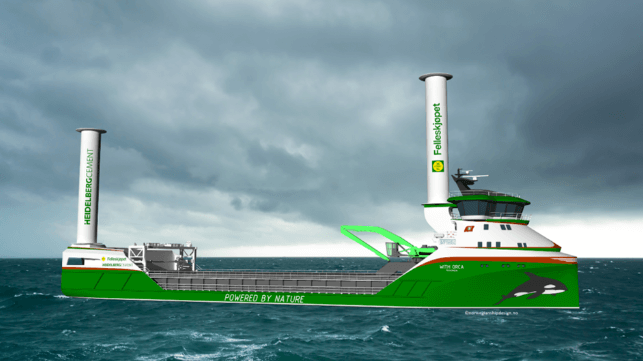Hydrogen-Fueled and Wind-Powered Bulker Receives Design Approval

A Norwegian project emerging from a competition to develop the world’s first zero-emission bulk carrier is proceeding toward its goal of launching service in 2024 after having received design approval. Incorporating hydrogen for its fuel with wind power and batteries for energy storage, the vessel known as With Orca is being called a milestone in the journey towards a zero-emission future for the shipping industry.
The project began in late 2020, and after a six-month competition, with more than 31 shipowners bidding, the With Orca project was selected. The vessel is being designed by Norwegian Ship Design and the hydrogen will be supplied by Statkraft. The Green Shipping Program, a public-private partnership for the development of environmentally advanced shipping projects, facilitated the competition where Felleskjøpet Agri and Heidelberg Cement joined forces in the competition to develop, build, and operate a hydrogen-powered zero-emission bulk carrier. The team selected Egil Ulvan Rederi, a family-owned shipowner based in Trondheim, Norway, to develop, build, and operate a zero-emission cargo ship.
Designs for the With Orca have now been awarded Approval in Principle (AiP) from Lloyd’s Register. LR awarded the AiP after completion of a risk-based HAZID certification drawing on the class society’s experience with hydrogen-fueled vessels and projects using novel fuels.
“We have been working with the project for more than 1.5 years, and the AiP confirms that we have made good design choices in our effort to create a safe, efficient, and feasible concept,” said Ivar Ulvan, owner and project manager of Egil Ulvan Rederi. “Receiving the AiP from Lloyd’s Register is an important milestone for us. We have learned a lot in the process towards the AiP.”
The design calls for a 5,500 ton vessel that will be approximately 289 feet in length. With Orca will be powered by hydrogen, stored onboard in compressed form, and the hydrogen combustion engine will be optimized for increased efficiency. The vessel will also have a fuel cell system for energy production in low-load conditions.
We have been working hard evaluating different solutions for the hydrogen system onboard,” said Gjermund Johannessen, CEO of Norwegian Ship Design. “We have developed a unique and safe hydrogen concept, and we used hydrogen’s special properties as one of the means to achieve this.”
The vessel’s route will mostly be in open waters in the North Sea, where weather conditions are ideal for wind-assisted propulsion according to the design team. As such, the vessel will also be fitted with two large rotor sails. They expect a significant part of the energy required to operate the vessel will be harvested directly from the wind through the rotor sails. The vessel also has the ability to store excess energy in batteries.
“LR is delighted to have been selected for this world’s first project that utilizes several alternative propulsion technologies,” said Mark Darley, Marine and Offshore Director for Lloyd’s Register. “Through our thorough risk-based analysis we are happy to award approval in principle for the use of hydrogen as a sustainable and safe solution for vessel propulsion.”
The self-discharging hydrogen-fueled bulk carrier is expected to enter service in 2024 demonstrating the capabilities of hydrogen and wind propulsion. With Orca will be transporting cargoes for Heidelberg Cement and Felleskjøpet. It will be carrying aggregates from western to eastern Norway and grain in the opposite direction.
